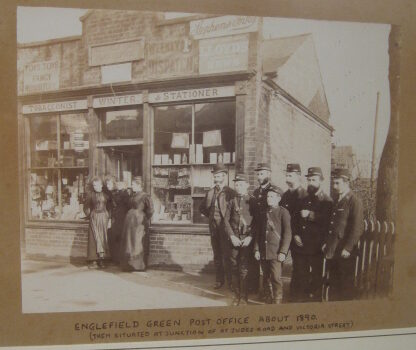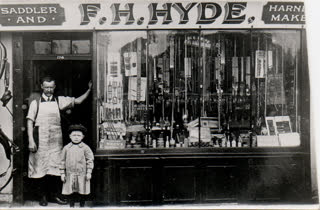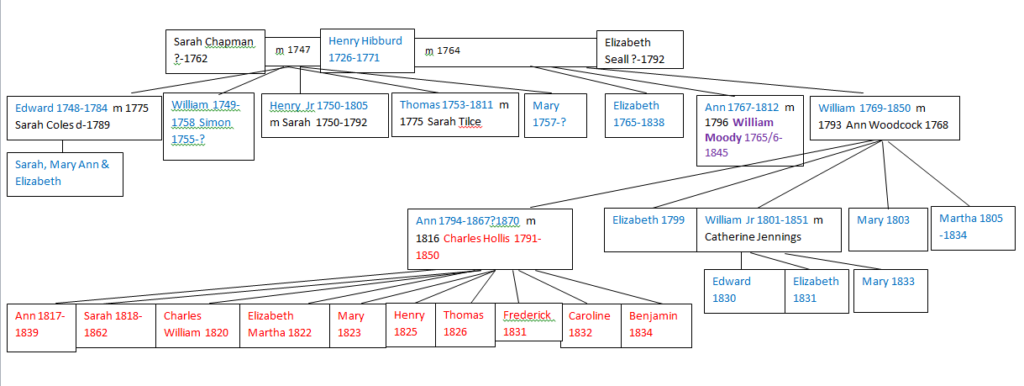Just Williams Part 8 – some of the Victorian tradesmen who shaped Egham High Street and Englefield Green
This short series of articles by Margaret Stewart has been looking at some of the businesses which began trading in Egham during the Victorian era and continued for over 50 years. There were similar businesses away from the centre of Egham itself and in the surrounding areas. What they have in common is that they were all begun by men called William…
8. William Hibburd, saddler High Street and William Moody, grocer St Jude’s Road
Royal Holloway graduate and museum volunteer Hannah Warren first encountered the name of William Moody, a grocer of Englefield Green, when she was looking at the will of another Egham resident. Her suggestion that he qualified for inclusion in this series led us on a winding trail involving two other families associated with the Egham area during the first 50 years of the nineteenth century – and the most challenging research of this series.
As William Moody died in 1845 the usual sources of census and local rate books were of no use. The census in England had been taken every ten years since 1801 but, until 1841, it was merely statistics with no details of individuals. Rates and land records listed names but not exact addresses. Without these usually invaluable sources of information we turned to baptismal, marriage and death certificates and wills.
The first key to the puzzle turned out to be a grave in St John’s Churchyard:
“Ann, Moody, wife of William Moody of E Green died 3rd August 1812 aged 45. Also Elizabeth Hibburd spinster died May 1838 age 73, also William Moody died 8th May 1843 aged 80 years, also William Hibburd of this parish died 17th April 1850 aged 81, also William Hibburd …”
This linked William Moody to the Hibburd family – and another William with a long-term business in Egham High Street.
William Hibburd (sometimes written Hibberd or even Hibbert) was born in Egham in 1769, the youngest of several children of Henry Hibburd, who traded locally as a collar maker, building up an impressive portfolio of properties, and his second wife, Elizabeth. In the eighteenth century the most likely occupation of a collar maker was to produce leather collars for horses: in an agricultural community like Egham this would have been a vital and lucrative trade. (In 1768 there was in fact another collar maker in Egham Hythe, Edward Denyer, who was supported by Henry Hibburd when he prosecuted his landlord for assault). When Henry Hibburd died in 1771 he was able to leave each of his surviving seven children (four from his first wife Sarah and three from Elizabeth) a considerable legacy of land in Egham and Staines:
- To Edward, (1748-84) the sum of £20 during the year after his death and also his entire ‘stock in trade.’ This implies that Edward who was then aged 23 was in partnership with Henry and would be carrying on his business. That £20 would be worth just over £4000 today. Edward died in 1784, leaving a widow, Sarah nee Coles, and three daughters, Sarah, Mary Ann & Elizabeth.
- To Henry (1750-1805) and Thomas (1753-1811), as soon as they were 21, the family home and two copyholds in Egham Street [sic], one of which was the Nag’s Head alehouse. It is not clear if Henry was part of the family business. Thomas[i] was a collarmaker. Like their brother Edward both Henry and Thomas married women called Sarah! Neither of them seem to have had children.
- To Mary, (1757-?) as soon as she was 21, property in Egham Street [sic]
- To Elizabeth (1765-1838), as soon as she was 21, copyhold on tenements lying in Egham
- To Ann (1767-1812) as soon as she was 21, a freehold half acre of farmland in Egham and also a leasehold cottage and tenement near the White Lion Inn and leasehold on a garden and orchard opposite the Malt House.
- To William, then aged 2, as soon as he was 21, six acres freehold arable land in Stainesfield? and 4 acres of copyhold land in Staines.
Most of the Hibburd family did not live much beyond the age of 50 – another two sons of Henry and Sarah had died in childhood. Either through further inheritance or sheer ability , it seems that William Hibburd had taken control of the business by 1793 as it was his name that then appeared in lists of Qualified Freeholders and Copyholders. Initially he continued the business of collar making but by 1794 he had expanded into harness making and finally became a saddler (saddle maker) in Egham High Street. He owned a number of properties in Egham – two houses and gardens which were leased out and land at Yard Mead (beside the Thames at Runnymede) – but where was his shop? By 1840, according to a tithe map of Egham it was almost opposite Strode’s and The Crown public house, exactly on the site formerly occupied by the Blue Ball public house, now 177-179 High Street.
The premises, actually owned by William Moody, was big enough to take three separate households: Williiam Hibburd and his wife; Charles Ridout, a surgeon (who later moved to 185 High Street, now Egham Youth Centre), and in 1841 25 year old Frederick Eyre who was also a saddler and presumably running the business at 178 High Street (now Big Fry) on behalf of William, then aged 70. No 178 continued to function as saddler or leather goods shop until 1994, under Arthur Trumper from 1851 and the Hyde family.
William had married local girl Ann Woodcock, also of an old Egham family, in St John’s Church in 1793. Land in the Yard Mead area was known as Woodcock’s Land into the 20th century so William’s holdings there may have been inherited from her father. They had five children, Ann (1794), Elizabeth (1799), Martha (1804-1824), William (1801) and Mary (1803).
In 1816 their daughter Ann Hibburd married Charles Hollis at St George’s Hanover Square, witnessed by her father William Hibburd & by Elizabeth Hibburd, either her sister or her aunt. They spent the first years of their married life in Teddington, producing nine children, before moving sometime after 1837 to London where Charles Hollis went to work as a piano maker with William Challen[ii] . By 1839 the firm had become Challen and Hollis. The Hollis family lived close to the Challens in Great Titchfield Street but clearly made visits to their relatives in Egham. Sadly their oldest daughter Ann Hollis died age 22 in 1839 and was buried in Egham in the same grave as her great-grandfather Thomas Woodcock.
William Hibburd died in 1850 and was buried at St John’s Church in the same grave as his sisters Ann Moody and Elizabeth Hibburd. His widow stayed in their house, with her unmarried daughters Elizabeth and Mary.
Elizabeth and Mary had become schoolmistresses, proprietors of their own school in Teddington where their pupils in 1841 included two of the Challen family, Elizabeth Challen 13 and Mary Challen 11, and their nieces Elizabeth Hibburd 10, Mary Hibburd 8 and Caroline Hollis 9. After they retired they moved back to Egham to live with their widowed mother at 179 High Street.
William Hibburd Junior became a clerk and lived firstly in Egham and then Ascot Heath, with his wife Catherine and their children. He died at just 50 years of age and was buried with his father in St John’s Churchyard.
William Moody appears to have been born in Wiltshire in 1765. He had moved to the Egham area by the early 1790s where he seems to have rented his first premises from Elizabeth Hibburd Senior. In 1796 he married her younger sister Ann Hibburd at St Marylebone, with William and (his wife) Ann Hibburd as witnesses. There were other Moodys in the Egham area but they do not seem to have been related.
By 1799 he was resident in Englefield Green, first as a tea dealer and later a grocer.
His business seems to have thrived to the extent that he was able to buy or lease a number of properties in Egham High Street, probably in addition to those brought to the marriage by his wife.
It seems that he and Ann had had no children by the time she died in 1812, aged 45, and was buried at St John’s. However William kept in touch with nieces and nephews still living in Wiltshire, probably the children of his brother John. One nephew, William Christopher Moody, came to live with William and probably to work with him in the grocer’s shop. The 1841 Census shows that William was still working as a grocer at the age of 75; William Christopher is listed as a labourer – something of a catch-all term in the 19th century. Also living with them were Elizabeth Martha Hollis and Mary Hollis, aged 18 and 17 respectively, his wife’s great nieces, the daughters of Charles and Ann Hollis.
William died in May 1845 aged 80 and left a very detailed will:
This is the last Will and Testament of me William Moody of Englefield Green in the Parish of Egham in the county of Surrey … I give and bequeath to Mary Hibburd the niece of my late wife my Gold Watch and seal. I give and bequeath a legacy of fifty pounds to Mary Hollis daughter of Charles Hollis of Great Titchfield Street London. I give and bequeath a legacy of nineteen pounds to my niece Jemima Judd. I give and bequeath a legacy of ten pounds to [J?] [B?] who married my niece since deceased, with legacies to be paid within three months next after my decease. I give and devise all that my freehold estate situate and being at Sunning Hill in the County of Berks consisting of five cottages and about three acres of land in the several occupations of … with every right …and appurtenant thereunto belonging to my nephew George Moody his heirs and assigns for ever. I give and bequeath to the said George Moody in addition to the above a legacy of ten pounds together with all my wearing apparel may die possessed of.
I give and devise all that my messuage or tenement situate and being in the High Street Egham and now in the … occupation of Charles Vie Ridout or his under tenant to the use of Elizabeth Hibburd the niece of my late wife and her assigns without impeachment of waste for and during the term of her natural life, and from and after the decease of the said Elizabeth Hibburd I give and devise the said messuage or tenement hereditaments and premises with every appurtenant to the same belonging to my nephew William Christopher Moody his heirs and assigns for ever. I give and bequeath a legacy of ten pounds to my executor the said Charles Hollis all the Rest Residue and Remainder of my estate and effects whatsoever and wheresoever and of whatever nature or kind … with all the rights members and appurtenances [to?] the same belonging I give devise and bequeath to the said William Christopher Moody his heirs executors and administrators and assigns for ever. I nominate constitute and appoint the said William Christopher Moody and the said Charles Hollis Executors of this my will and hereby [revoking?] all former and other wills by me at any time heretofore made declare this to be my last will and testament in witness whereof I have hereunto set my hand and seal this fifth day of May one thousand eight hundred and forty three.
Will of William Moody (found on Ancestry.com) – Proved 8th October 1845. Transcribed by Hannah Warren
William was buried with his wife and sister-in-law Elizabeth Hibburd in St John’s churchyard.
It was perhaps on the strength of inheriting the grocery business, shop and house that William Christopher married Frances Atkin from Hitchin in October 1845. They continued the business together and in 1855 added the role of sub postmaster & receiver of post for Englefield Green, raising two daughters, Elizabeth (1847) and Sarah (1849) until William Christopher’s mysterious death in 1859.
According to the local paper[iii] he left his home about 2pm on Friday 4th March and took a ferry to Wraysbury from where he caught a train to Staines and proceeded next day to Salisbury “his native place”. He returned on Sunday by train to Weybridge, walked to Chertsey and was not seen again until his body was found in The Thames near Ankerwyke on Wednesday 9th. He had apparently been suffering from depression but it was not possible to confirm that he had committed suicide. The Post Office agreed that Frances Moody should continue with the business, and the shocked community of local shopkeepers raised money to help the family.
The grocery may not have been as successful under Frances. In 1866 she was summonsed for fraudulent trading – adding weights to her weighing scale to falsify the quantities sold – and fined seven shillings and sixpence (35penc,e equivalent to just over £51 today).[iv]
However she continued to run the shop and post office. Her older daughter Elizabeth died in 1886, when Frances was living at 4 South Terrace. Frances died, aged 72, in 1889. Sarah followed in 1893, aged just 44. The grocery business seems to have closed and been replaced by a tobacconist’s shop run by William Winter who also took over the post office. His shop in St Jude’s Road is likely to be the one vacated by the Moody family, which remained Englefield Green Post Office into the 20th century.

After almost 100 years the businesses established in the Egham and Englefield community by William Hibburd and William Moody had come to an end.
General sources: Egham Museum photograph and document collections (including rate books), https://www.ancestry.co.uk, https://www.findmypast.co.uk
Many thanks to Hannah Warren for finding details of Jemima Judd and George Moody in Wiltshire and for her amazing skill in deciphering mid-nineteenth century wills,
[i] Both Edward and Thomas were charged with fathering illegitimate children in 1769 and 1775 respectively. Silverthorne, Elizabeth ed. (1978) Deposition book of Richard Wyatt JP, 1767-1776, Guildford, Surrey Record Office, Surrey Record Society Vol 30
[ii] Challen Pianos won a reputation for producing good-quality pianos at moderate prices. Challen specialized in small grand pianos, and made the smallest on the market (122 cm long).They also made the world’s largest grand, at twelve feet long, to mark the silver jubilee of King George V and Queen Mary in 1935 Since the 1930s over 180 Challen pianos, from large concert grand pianos to small studio uprights have been used in BBC studios. The firm was later acquired by Barratt & Robinson but Challen pianos are still much sought after.

[iii] Windsor and Eton Express, 12 March 1859
[iv] Windsor and Eton Express, 1 September 1866
[v] Local rumour says that sometime after this photograph was taken, William Winter eloped with the shop assistant Miss Henderson. Certainly he left Egham but the 1891 census found him in Essex, still accompanied by his wife Emily.






